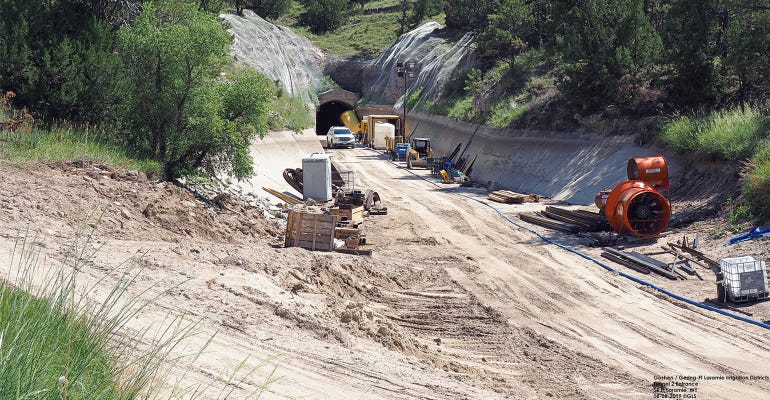
Irrigators in western Nebraska and eastern Wyoming breathed a collective sigh of relief in late August when USDA's Risk Management Agency announced it had "concluded that the 2019 collapse of the Goshen/Gering-Ft. Laramie Canal tunnel was due to failure of irrigation water supply resulting from an insurable cause of loss."
Not long after, water began flowing into the tunnel once again, returning irrigation water to more than 100,000 acres of cropland in Nebraska and Wyoming.
The tunnel collapsed July 17, and the Goshen Irrigation District and Gering-Ft. Laramie Irrigation District have been working around the clock to repair the breach in the tunnel ever since.
The tunnel was built more than 100 years ago — about 2,200 feet long with about 2 feet of drop over that distance, and about 14 feet in diameter, with poured concrete forming the outer wall of the tunnel. Some have speculated that the tunnel collapsed as a result of a cavity eroded over the top of the tunnel between the poured concrete and the substrate above.
Jessica Groskopf, Nebraska Extension agricultural economist in the Panhandle, notes growers affected by the collapse need to continue to manage their crop to the best of their abilities.
"Growers need to attempt to irrigate that ground, even if they don't feel it will improve the yield," Groskopf says. "As long as growers have water and it's viable to irrigate, they need to attempt to irrigate their ground."
That includes gravity-irrigated crops — growers need to have laid out pipe and set tubes. While questions may come up at the individual level whether growers qualify if they didn't lay pipe or dig furrows, growers will need to work with individual insurance agents on these issues.
Losses not yet known
While initial estimates put the total economic impact in crop loss at about $89 million, the estimates were made before the Risk Management Agency announced crop losses caused by the tunnel collapse would be covered. The total losses likely will be lower, but the actual numbers won't be known until crops are harvested.
John Thomas, Nebraska Extension educator for the Panhandle, notes within the more than 100,000 acres affected, some areas have been hit harder than others.
"I have some time-lapse cameras on one farm in the south Mitchell Valley," Thomas says. "At least in that area, crops have been better than I thought. If it would have been extremely hot and dry, I think we'd have major crop failure, but things have been a little cooler and wetter. Those crops are going to take a hit on yield, no doubt about it, but it's going to vary from place to place. Some people might be surprised at the yields they get. Other people may take a pretty hard hit."

AROUND THE CLOCK: Since the tunnel collapsed July 17, the Goshen Irrigation District and Gering-Ft. Laramie Irrigation District have been working around the clock to repair the breach. Now, questions remain regarding infrastructure updates.

For those preparing to harvest sugarbeets, hard, dry ground can pose challenges.
"There can be a real issue getting sugarbeets dug if the ground is dry and concrete hard," Thomas says. "If we either have some rains, or we have water in the canal and are allowed to irrigate later into the year, that's a possibility that will help us with sugarbeet harvest. Maybe with some additional water, those beets will keep growing as long as they don't get frozen."
In early September, it was announced the U.S. Bureau of Reclamation agreed to allow irrigation districts to divert water past their contract date of Sept. 30 based on demand and weather conditions, providing farmers an additional opportunity to irrigate crops such as sugarbeets — and providing additional soil moisture going into the next cropping season, says Gary Stone, Nebraska Extension educator.
"Attitudes are certainly better. Things aren't as dire as they were when we first heard the news of the tunnel collapse on July 17," Stone says. "At least for now, irrigators know they should be able to get water for next year."
Long-term updates needed
While the breach has been repaired, questions have been raised on the need for long-term improvements in irrigation infrastructure in the region. The tunnel is one of three in the Goshen/Gering-Ft. Laramie Canal system, and irrigators and other stakeholders in the area have expressed concern over the integrity of the other tunnels.
"It's not the only canal in this region and not the only tunnel in this canal system," Groskopf says. "Moving forward, we need to think about how reliant we are on a system that is fragile. It happened to be this canal this time. It happened to be this year, when we had rain, but that doesn’t mean it can't and won't happen again. Irrigation districts are trying to work with the Bureau of Reclamation to get permanent repair dollars. They've offered $4 million for a 50-year loan, but it doesn’t cover the total repairs. A total repair of that system is needed, and we need to discuss how that's going to happen."
"The big question that remains unanswered is: Where do we get the money?" adds Stone, noting it would cost an estimated $40 million to $50 million to update all three tunnels in the system. "Even though they've patched this breach, the Goshen Irrigation District recently posed the question: How long will this patch work? We don't know, but we don't think it will last more than three years. I think the Bureau of Reclamation would like to see something more permanent."
About the Author(s)
You May Also Like






